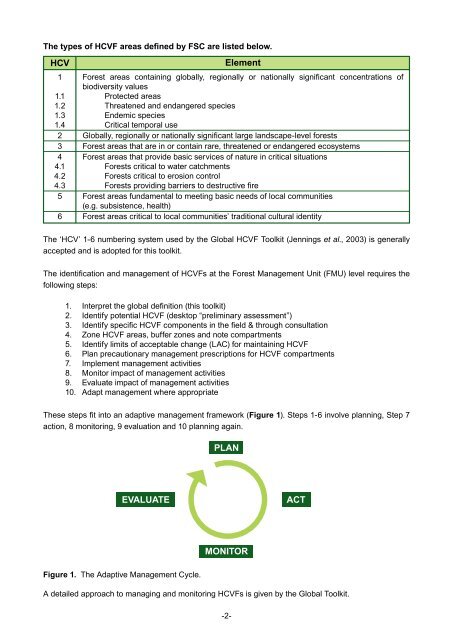(HCVF) Toolkit for Malaysia - HCV Resource Network
(HCVF) Toolkit for Malaysia - HCV Resource Network
(HCVF) Toolkit for Malaysia - HCV Resource Network
You also want an ePaper? Increase the reach of your titles
YUMPU automatically turns print PDFs into web optimized ePapers that Google loves.
The types of <strong><strong>HCV</strong>F</strong> areas defined by FSC are listed below.<br />
<strong>HCV</strong><br />
1<br />
1.1<br />
1.2<br />
1.3<br />
1.4<br />
2<br />
3<br />
4<br />
4.1<br />
4.2<br />
4.3<br />
5<br />
6<br />
Element<br />
Forest areas containing globally, regionally or nationally significant concentrations of<br />
biodiversity values<br />
Protected areas<br />
Threatened and endangered species<br />
Endemic species<br />
Critical temporal use<br />
Globally, regionally or nationally significant large landscape-level <strong>for</strong>ests<br />
Forest areas that are in or contain rare, threatened or endangered ecosystems<br />
Forest areas that provide basic services of nature in critical situations<br />
Forests critical to water catchments<br />
Forests critical to erosion control<br />
Forests providing barriers to destructive fire<br />
Forest areas fundamental to meeting basic needs of local communities<br />
(e.g. subsistence, health)<br />
Forest areas critical to local communities’ traditional cultural identity<br />
The ‘<strong>HCV</strong>’ 1-6 numbering system used by the Global <strong><strong>HCV</strong>F</strong> <strong>Toolkit</strong> (Jennings et al., 2003) is generally<br />
accepted and is adopted <strong>for</strong> this toolkit.<br />
The identification and management of <strong><strong>HCV</strong>F</strong>s at the Forest Management Unit (FMU) level requires the<br />
following steps:<br />
1. Interpret the global definition (this toolkit)<br />
2. Identify potential <strong><strong>HCV</strong>F</strong> (desktop “preliminary assessment”)<br />
3. Identify specific <strong><strong>HCV</strong>F</strong> components in the field & through consultation<br />
4. Zone <strong><strong>HCV</strong>F</strong> areas, buffer zones and note compartments<br />
5. Identify limits of acceptable change (LAC) <strong>for</strong> maintaining <strong><strong>HCV</strong>F</strong><br />
6. Plan precautionary management prescriptions <strong>for</strong> <strong><strong>HCV</strong>F</strong> compartments<br />
7. Implement management activities<br />
8. Monitor impact of management activities<br />
9. Evaluate impact of management activities<br />
10. Adapt management where appropriate<br />
These steps fit into an adaptive management framework (Figure 1). Steps 1-6 involve planning, Step 7<br />
action, 8 monitoring, 9 evaluation and 10 planning again.<br />
PLAN<br />
EVALUATE<br />
ACT<br />
MONITOR<br />
Figure 1. The Adaptive Management Cycle.<br />
A detailed approach to managing and monitoring <strong><strong>HCV</strong>F</strong>s is given by the Global <strong>Toolkit</strong>.<br />
-2-

















